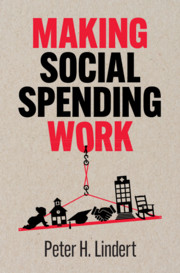Book contents
- Making Social Spending Work
- Making Social Spending Work
- Copyright page
- Dedication
- Contents
- Figures
- Tables
- Appendices
- Part I Overview
- Chapter 1 Enduring Issues
- Chapter 2 Findings and Lessons
- Part II The Long Rise, and Its Causes
- Part III What Effects?
- Part IV Confronting Threats
- Acknowledgments
- Notes
- References
- Index
Chapter 1 - Enduring Issues
from Part I - Overview
Published online by Cambridge University Press: 01 April 2021
- Making Social Spending Work
- Making Social Spending Work
- Copyright page
- Dedication
- Contents
- Figures
- Tables
- Appendices
- Part I Overview
- Chapter 1 Enduring Issues
- Chapter 2 Findings and Lessons
- Part II The Long Rise, and Its Causes
- Part III What Effects?
- Part IV Confronting Threats
- Acknowledgments
- Notes
- References
- Index
Summary
Human societies have always needed safety nets to catch those who end up in need. The risks have always been there. Only recently has there been a global surge in government social spending. The major historical issues raised by this long delay are introduced in this chapter. Readers are given spoiler alerts about whether it had to be government that spread the nets, and about whether large-spending countries got the mix of social spending wrong more often than did low-spending governments. The conventional arguments for and against tax-based social spending are introduced.
Information
- Type
- Chapter
- Information
- Making Social Spending Work , pp. 3 - 10Publisher: Cambridge University PressPrint publication year: 2021
